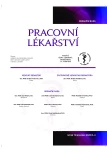Risk Factors of Work at the Department of Pathology
Authors:
M. Kolečková 1; E. Srovnalová 1; A. Boriková 2; M. Nakládalová 2
Authors‘ workplace:
Ústav klinické a molekulární patologie, Lékařská fakulta Univerzity Palackého a Fakultní nemocnice Olomouc, vedoucí prof. MUDr. Jiří Ehrmann, Ph. D.
1; Klinika pracovního lékařství, Lékařská fakulta Univerzity Palackého a Fakultní nemocnice Olomouc, vedoucí doc. MUDr. Marie Nakládalová, Ph. D.
2
Published in:
Pracov. Lék., 72, 2020, No. 3-4, s. 41-46.
Category:
Review Article
Overview
The nature of work in the departments of pathology has undergone a radical development in recent decades. The current trend in the field is focused primarily on accurate histological diagnosis and determination of the etiopathogenesis of disease. It uses a number of auxiliary methods for these purposes. The introduction of molecular pathology into modern medicine, opening up the new possibilities in the prognosis estimation and predicting the response to given therapy, strengthens the key position of the pathologist in the patient's life.
The work is classified as 3rd risk category with a possible negative impact on the health of employees. The health care workers in the Departments of Pathology are globally exposed to various chemical and biological risk factors. However, significant visual, mental and physical strain cannot be overlooked.
The aim of the study is information on the basic procedures of work at individual pathology workplaces in connection with occupational risk factors and related legislation.
Keywords:
department of pathology – risk factors of work – work categorization – chemical substances – biological agents – healthcare professionals
Sources
1. Zákon č. 258/2000 Sb., o ochraně veřejného zdraví.
2. Zákon č. 262/2006 Sb., zákoník práce.
3. Vyhláška č. 432/2003 Sb., kterou se stanoví podmínky pro zařazování prací do kategorií, limitní hodnoty ukazatelů biologických expozičních testů, podmínky odběru materiálu pro provedení biologických expozičních testů a náležitostí hlášení prací s azbestem a biologickými činiteli.
4. Zákon č. 373/2011 Sb., o specifických zdravotních službách v platném znění.
5. Vyhláška č. 306/2012 Sb. o podmínkách předcházení vzniku a šíření infekčních onemocnění a o hygienických požadavcích na provoz zdravotnických zařízení a ústavů sociální péče.
6. Vyhláška č. 473/2008 Sb., o systému epidemiologické bdělosti pro vybrané infekce.
7. Fritzsche, F. R., Ramach, C., Soldini, D. et al. Occupational health risks of pathologists – results from a nation wide online questionnaire in Switzerland. BMC Public Health, 2012, 12, s. 1054.
8. Nařízení Evropského parlamentu a Rady (ES) č. 1272/2008, o klasifikaci, označování a balení látek a směsí, o změně a zrušení směrnic č. 67/548/EHS a 1999/45/ES a o změně nařízení (ES) č. 1907/2006.
9. Duong, A, Steinmaus, C., McHale, C. M. et al. Reproductive and developmental toxicity of formaldehyde: a systematic review. Mutat Res., 2011, 728, č. 2, s. 118–138.
10. McHale, C. M., Smith, M. T., Zhang, L. Application of toxicogenomic profiling to evaluate effects of benzene and formaldehyde: from yeast to human. Ann N Y Acad Sci., 2014, 1310, č. 1, s. 74–83.
11. Rajan, S., Malathi, N. Health hazards of xylene: a literature review. J Clin Diagn Res., 2014, 8, č. 2, s. 271–274.
12. Masekameni, M. D., Moolla, R., Gulumian, M. et al. Risk Assessment of Benzene, Toluene, Ethyl Benzene, and Xylene Concentrations from the Combustion of Coal in a Controlled Laboratory Environment. Int J Environ Res Public Health., 2018, 16, č. 1, s. 95.
13. National Center for Biotechnology Information. PubChem Database. Lead nitrate, CID=24924, https://pubchem.ncbi.nlm.nih.gov/compound/Lead-nitrate (accessed on June 23, 2020).
14. National Center for Biotechnology Information. PubChem Database. Mercuric chloride, CID=24085, https://pubchem.ncbi.nlm.nih.gov/compound/Mercuric-chloride (accessed on June 23, 2020).
15. National Center for Biotechnology Information. PubChem Database. Osmium dioxide, CID=187574, dostupný na www: https://pubchem.ncbi.nlm.nih.gov/compound/osmium%20dioxide (accessed on June 23, 2020).
16. National Center for Biotechnology Information. PubChem Database. Sulfuric acid, CID=1118, dostupný na www: https://pubchem.ncbi.nlm.nih.gov/compound/Sulfuric-acid (accessed on June 23, 2020).
17. National Center for Biotechnology Information. PubChem Database. Chloric acid, CID=19654, dostupný na www: https://pubchem.ncbi.nlm.nih.gov/compound/Chloric-acid (accessed on June 23, 2020).
18. Takigawa, T., Endo, Y. Effects of glutaraldehyde exposure on human health. J Occup Health, 2006, 48, 75–87.
19. Kolman, A., Chovanec, M., Osterman-Golkar, S. Genotoxic effects of ethylene oxide, propylene oxide and epichlorohydrin in humans: update review (1990–2001). Mutation Research, 2002, 512, 173–194.
20. Liu, S., Yao, Y., Lu, S. et al. The role of renal proximal tubule P450 enzymes in chloroform-induced nephrotoxicity: utility of renal specific P450 reductase knockout mouse models. Toxicol Appl Pharmacol., 2013, 272, č. 1, 230–237.
21. National Center for Biotechnology Information. PubChem Database. Chloroform, CID=6212, dostupný na www: https://pubchem.ncbi.nlm.nih.gov/compound/Chloroform (accessed on June 23, 2020).
22. Hernández-Zamora, M., Martínez-Jerónimo, F., Cristiani--Urbina, E. et al. Congo red dye affects survival and reproduction in the cladoceran Ceriodaphnia dubia. Effects of direct and dietary exposure. Ecotoxicology, 2016, 25, č. 10, 1832–1840.
23. UK Teratology Information Service (UKTIS). Ammonia exposure in pregnancy, 2012.
Labels
Hygiene and epidemiology Hyperbaric medicine Occupational medicineArticle was published in
Occupational Medicine

2020 Issue 3-4
Most read in this issue
- Local muscular load of the upper limbs – methodical instructions to ensure a uniform procedure for authorized measurement, assessment and interpretation of the results of measurement of local muscular load by the method of integrated electromyography – design
- Risk Factors of Work at the Department of Pathology
-
Covid-19 as an occupational disease – primary medical and legal considerations
(legal status to 31 December 2020) - Co dělat, až skončí epidemie?
